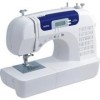Brother International CS6000i User Guide - Page 47
Reinforcement Stitching - button hole
 |
UPC - 012502615309
View all Brother International CS6000i manuals
Add to My Manuals
Save this manual to your list of manuals |
Page 47 highlights
NCBC2000.book Page 46 Thursday, October 21, 2004 4:32 PM UTILITY STITCHES REINFORCEMENT STITCHING Reinforce points that will be subject to strain, such as sleeve holes, inseams and pocket corners. Pattern Presser Foot 70 stitches model 60 stitches model 50 stitches model 40 stitches model Twin Needle Walking Foot Reverse/ Reinforcement Stitching Stitch Name Pattern No. Application Stitch Width [mm (inch.)] Stitch Length [mm (inch.)] Auto Manual Auto Manual Triple stretch stitch Attaching sleeves, sew- J 02 02 02 02 ing inseams, sewing stretch fabrics and deco- 0.0 (0) rative stitching 0.0-7.0 (0-1/4) 2.5 (3/32) 1.5-4.0 (1/16-3/16) No No Rfc.* Bar tack stitch A Reinforcing openings 36 36 34 30 and areas where the seam easily comes loose 2.0 (1/16) 1.0-3.0 (1/16-1/8) 0.4 (1/64) 0.3-1.0 (1/64-1/16) No No Auto** Rfc. *Rfc.: Reinforcement **Auto Rfc.: Automatic Reinforcement Triple stretch stitching Use triple stretch stitching to reinforce sleeve holes and inseams. Attach zigzag foot "J". a Select stitch . b Start sewing. c • For details, refer to "Starting to sew" (page 28). Bar tack stitching Bar tacks are used to reinforce points subject to strain, such as pocket corners and openings. As an example, the procedure for sewing bar tacks at pocket corners is described below. Determine the desired length of the bar tack. a Set the button guide plate on buttonhole foot "A" to the desired length. (The distance between the markings on the presser foot scale is 5 mm (3/16 inch).) 1 2 3 a Presser foot scale b Length of bar tack c 5 mm (3/16 inch) • A bar tack with a maximum length of about 28 mm (1-1/8 inch) can be sewn. Attach buttonhole foot "A". b 46















